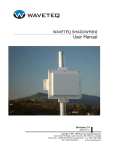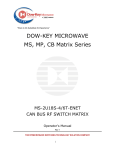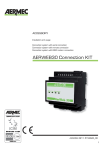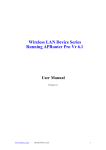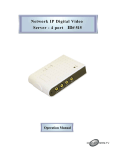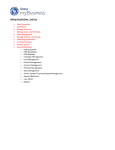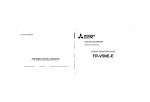Download Broadband Router User`s Manual
Transcript
Broadband Router User’s Manual Table of Contents Chapter 1 Introduction ..............................................4 1.1 The Broadband Router …………………...……………...........4 1.2 Physical Features of Broadband Router……………………...4 1.3 Non-Physical Features of Broadband Router……………..…4 1.4 Package Checklist……………………………………………... 6 1.5 Installation Requirements……………………………………..7 1.6 About this User’s Manual……………………………………...7 Chapter 2 Get to Know The Hardware....................8 2.1 LED Indicators…………………………………………………...8 2.2 Back Panel……………………………………………………… 9 1. 2. 3. 4. Local LAN Ports ....................................................................................9 Internet WAN Port .................................................................................9 Reset Button...........................................................................................9 Power Connector..................................................................................10 Chapter 3 Install Yo ur Broadband Router.............11 3.1 Connect Client PC to Broadband Router……………………………….11 3.2 Connect Ethernet Hub/Switch to Broadband Router……………….….11 1 3.3 Connect Wireless Access Point to Broadband Router.………………….11 3.4 Connect Cable/xDSL Modem to Broadband Router…………………....11 3.5 Power up Broadband Router………………………………………….….11 Chapter 4 4.1 Use Your Broadband Router .................13 Check the Web Proxy………………………………………... 13 4.2 Wizard Setup………………………………………………….13 4.3 WAN Setup Complete………………………………………...20 Chapter 5 Advanced Setup of Broadband Router 21 5.1 Start from Advanced Setting………………………………… 21 5.4 Administration………………………………………………..23 WAN Side Administration.............................................................................24 5.5 Firmware Upgrade…………………………………………...24 5.6 Reset…………………………………………………………... 26 5.7 Dynamic DNS (Domain Name System)……………………...27 5.8 DHCP Server……………………………………………….…29 1. 2. 3. 4. DHCP Definition..................................................................................29 DHCP Server in LAN ..........................................................................29 DHCP Client in LAN ...........................................................................30 Static IP Assign ....................................................................................30 2 5. 5.9 DHCP Client List .................................................................................31 Virtual Server (Port Forwarding)…………………………...31 5.10 Firewall………………………………………………………33 1. 2. 3. 4. 5. 6. DMZ Host Configuration.....................................................................33 Anti PING and TCP/UDP Echo Attack ...............................................36 URL Filter ............................................................................................36 Port Filter .............................................................................................37 MAC Filter ...........................................................................................38 IP Filter.................................................................................................39 Chapter 6 Troubleshooting..........................................40 6.1 Troubleshooting 40 1. 2. 3. 4. Router’s Hardware Failure ...................................................................40 Failed Connection between Broadband Router and Client PC ............40 Failed Connection on Broadband Router’s WAN Side........................41 DNS (Domain Name System) Failure .................................................41 6.2 Forget Password?.....................................................................42 Appendix A: Configure TCP / IP in Your PC............43 A.1 Enable DHCP in Your PC……………………………………43 1. 2. 3. For Windows 98 / ME..........................................................................43 For Windows 2000 ...............................................................................45 For Windows XP ..................................................................................48 A.2 Verify IP Settings……………………………………………..52 1. 2. 3. For Windows 98 / ME..........................................................................52 For Windows 2000 ...............................................................................54 For Windows XP ..................................................................................56 Appendix B: Common Port Numbers........................58 3 ? Chapter 1 Introduction Thank you for purchasing Broadband Router. This chapter covers a brief description of Broadband Router’s features, package content, installation requirements, and the organization overview of this User ’s Manual. 1.1 The Broadband Router The Broadband Router is an ideal Broadband (Small Office and Home Office) Router for sharing single Internet connection with multiple users, providing firewall security, and access at high speed. Broadband Router offers simple operation and easy setup. It also provides networking professionals with advanced features like DMZ, Virtual Server (Port Forwarding), Service Filtering, URL Filtering, and Dynamic DNS etc. Broadband Router will help you securely connect multiple PCs to the Internet via a broadband Cable or xDSL modem and becomes your best partner for your network needs. 1.2 Physical Features of Broadband Router • • • Auto-Sensing Ethernet Switch Broadband Router is equipped with a 4-port switch featuring auto-detect 10/100Mbps and auto-crossover. You can use either a Straight-Through or a Crossover cable to connect your client PC to the LAN port of Broadband Router. 10 / 100 Mbps Ethernet WAN The 10 / 100 Mbps Ethernet WAN port is connects to the Internet via a Cable or xDSL modem. Reload Button You can use the hardware Reload button to restore the factory default settings into Broadband Router. 1.3 Non-Physical Features of Broadband Router • Network Address Translation (NAT)/IP Sharing Broadband Router can translate the source IP address of a LAN client to the IP address of a WAN client before forwarding a packet from the LAN to the WAN. When the packet returns, NAT translates the destination address from a WAN 4 • • • • • • • client to the address of a LAN client before forwarding the packet back to the LAN client. When only one WAN IP address is available, NAT can translate the single WAN IP address into multiple LAN IP addresses for the LAN clients. Therefore the LAN clients “share ” the a single WAN IP address, and this is called IP Sharing. Firewall Broadband Router provides protection against Ping and TCP/UDP Echo Attack, Hacker’s Scan, and Denial of Service (DoS). Also it offers Service Filter and URL Filter (by Keyword). Dynamic DNS Dynamic DNS (Domain Name System) allows you to register and obtain a fixed domain name from DDNS service providers that Broadband Router supports. When your Broadband Router obtains a dynamic public IP address, it will inform the DDNS service provider with an updated IP address. Any connection toward your domain name will be mapped to the updated IP address by your DDNS service provider. You can be found easily by connecting to your fixed domain name. Virtual Server (Port Forwarding) Broadband Router can forward the service packet specified with a port number to the LAN host specified by the LAN IP address. In other words, Broadband Router can open the port for the service with specified port number and then “forward” the port to a LAN host. Thus it is called Port Forwarding, too. VPN Pass-Through In a Virtual Private Network, Broadband Router supports the tunneling of Point-to-Point Tunneling Protocol (PPTP) packet and allows it to enter the LAN that is the endpoint of the VPN. Special Application Certain Internet applications use multiple ports, port ranges, dynamically assigned ports, and special protocols. Broadband Router supports the transparent pass-through of these special applications, including FTP, ICMP, NetMeeting / H.323, Real Radio, Quick Time, MSN Messenger, etc. and many popular Internet Games. Public DMZ Host Public DMZ Host is a device with a public IP address on the LAN side. Broadband Router provides the tunnel service for data traffic between the Public DMZ Host and the Internet. Local DMZ Host Local DMZ Host is a device with a private IP address on the LAN side. 5 • Broadband Router can forward the traffic initiated from the Internet to the Local DMZ Host. DHCP Client Broadband Router can work as DHCP client and automatically obtain an IP address from the Internet Service Provider or a DHCP server on the WAN side. • DHCP Server • • • • • As DHCP server, Broadband Router can automatically assign TCP/IP settings to each client PC on the LAN side and remember each client’s IP address corresponding to the client’s MAC address. When Broadband Router assigns TCP/IP settings in the next time, the LAN client will receive the same LAN IP address. Remote Management Broadband Router can be configured and managed from the WAN side via a specific port. MAC Clone Broadband Router allows users to specify the MAC address of the Network Interface Card if Internet Service Provider has the requirement. Web-Based Setup Broadband Router can be managed through the Web browser in a LAN client PC connected to Broadband Router or the Internet. Web-Based Firmware Update Broadband Router ’s firmware can be updated easily via the Web Configuration Tool. Reload Broadband Router can restore the factory default settings via the Web Configuration Tool. 1.4 Package Checklist Please check the package contents of Broadband Router to verify that you have received the items below. (Figure 1-1) 1. One Broadband Router. 3. One AC Power Adapter 4. One Quick Installation Guide 5. One CD-ROM with User’s Manual If any of the items is incorrect, damaged, or missing, please immediately inform your dealer. Please retain the carton and the original packing 6 material in case there is a need to return the product. 1.5 Installation Requirements Before installing your Broadband Router, be sure you have prepared the following requirements. 1. A Computer equipped with 10/100 BASE-T Ethernet Network Interface Card. 2. TCP/IP protocol installed in the computer 3. Web Browser (Internet Explorer version 5.0 and higher / Netscape Navigator version 6.23 and higher) 4. One Cable Modem or xDSL Box 5. Broadband Internet Service 1.6 About this User’s Manual This User ’s Manual covers Broadband Router’s hardware, installation, configuration, and troubleshooting etc. Each chapter provides detailed information and helps you acquire clear concepts of Broadband Router. Enjoy your use of Broadband Router! Organization of This User’s Manual Chapter 1, Introduction It briefly describes the features of Broadband Router. Chapter 2, Get to Know the Hardware It explains the LED and port functions on the front and back panels. Chapter 3, Install Your Broadband Router It explains the hardware setup. Chapter 4, Use Your Broadband Router It explains Broadband Router’s setup via “Setup Wizard” in the Web Configuration Tool. Chapter 5, Configure Your Broadband Router It describes the default functions and advanced features via the Web Configuration Tool. Appendix A, Configure TCP/IP in Your PC It provides the procedure of enabling DHCP client, disabling Web Proxy, and verifying the IP settings in your client PC according to different Operating Systems. Appendix B, Common Port Numbers It offers a list of commonly used port numbers. 7 ? Chapter 2 Get to Know the Hardware This Chapter explains Broadband Router’s LED and Port functions. 2.1 LED Indicators Figure 2-1 The LEDs on the front panel show the operational status of your Broadband Router. The function of each LED is illustrated in table 2-1. LED Indicator Color Status Power Green Solid Power applied to Broadband Router Blinking N/A Status Green Router has boot successful N/A LAN 1 LAN 2 Green Local Ethernet connection established Receiving or transmitting packets Green Internet connection established Receiving or transmitting packets LAN 3 LAN 4 WAN Table 2-1 LED Descriptions 8 2.2 Back Panel On the back panel, Broadband Router has 4 RJ-45 10/100Mbps Ethernet LAN ports, and 1 RJ-45 10/100Mbps Ethernet WAN port. In addition, it has a Reload button and a Power Connector. (Figure 2-2) Figure 2-2 1. Local LAN Ports Broadband Router can function as a communication bridge between the LAN and the WAN. The 4 LAN ports can connect Broadband Router to the client PCs in the LAN. 2. Internet WAN Port The Internet WAN port provides connection between Broadband Router and Cable Modem or xDSL Box. 3. Reset Button The reset Button can be used to restore the factory default parameters such as the password and configuration settings. If you forget your password or want to restore the factory default settings into your Broadband Router, use the reset button. Step 1. Disconnect Broadband Router ’s power adapter from the power outlet. Step 2. Press the Reset button on the back panel and keep holding it. Then plug Broadband Router’s power adapter into the power outlet. Step 3. It takes around 15 seconds to reset the router. The Power LED will turn on (Green) initially. Wait until it becomes Red then release the Reset button. Step 4. Try to connect http://192.168.1.1/ via your Web browser. Use the user name 9 “admin” and the password “admin ” to obtain authentication. If it is failed, please try the approach again. 4. Power Connector Power connector connects your Broadband Router to the power adapter. When Broadband Router is connected to the correct power adapter and the power adapter is plugged into a power outlet, the Power LED will be on and Broadband Router will boot and start operating. 10 Chapter 3 Install Your Broadband Router 3.1 Connect Client PC to Broadband Router Use an Ethernet cable to connect your client PC to Broadband Router’s local LAN port. Broadband Router supports auto-crossover, so you can use either a Straight- Through cable or a Crossover cable to connect the client PC to the LAN port. 3.2 Connect Ethernet Hub/Switch to Broadband Router If you have more than four clients, connect a hub or switch to any of the Broadband Router’s LAN ports with an Ethernet cable, then connect each client PC to the hub or switch with an Ethernet cable as well. 3.3 Connect Wireless Access Point to Broadband Router You can extend the wired LAN by connecting Wireless Access Point to Broadband Router ’s LAN port. Then a wireless network will be set up and it will turn into an infrastructure mode. The whole network coverage will be expanded by Access Point wireless connection to the wireless clients. 3.4 Connect Cable/xDSL Modem to Broadband Router Use the Ethernet cable to connect a Cable Modem or xDSL Box to Broadband Router ’s Internet WAN port. 3.5 Power up Broadband Router Connect the correct Power Adapter to Broadband Router. Then plug the Power Adapter into an AC power outlet. The LED status will be as followed. 1. Power LED and the 4 LAN port’s LED will turn on for the first second. 2. The Power LED will be continuously on when the power is supplied. It takes around 15 seconds to boot. 3. The WAN and LAN link/act LED will be continuously on when Broadband Router is connected to the WAN and the LAN. The link/act LED will be 11 flashing when the port is transmitting data. The WAN and LAN 100 LED will be continuo usly on when the transmission mode is 100Mbps. It will be off when the transmission mode is in 10Mbps. Please use the correct AC adapter. It may cause damage to the router if an improper AC adapter was used. If the Power LED is not on, please refer to 6.1 Troubleshooting 12 Chapter 4 Use Your Broadband Router Follow the instructions in this chapter to perform the setup via “Quick Setup.” If you want to learn more about the DHCP setup of your client PC, please refer to the section of A.1 Enable DHCP in Your PC in Appendix A: Configure TCP/IP in Your PC. 4.1 Check the Web Proxy Because the enabled-Web Proxy setting may cause failure in accessing Broadband Router ’s Web Configuration Tool, verify that you have disabled the Web Proxy before launching your Web browser. If you do not know how to disable the Web Proxy, refer to the section of Disable Web Proxy in Appendix A: Configure TCP/IP in Your PC. 4.2 Wizard Setup Step1. Launch a web browser on your client PC connected to Broadband Router. Then point the Web browser to http://192.168.1.1 (http://192.168.1.1 is Broadband Router’s default IP address.) If the router IP address was configured with different IP address, use the configured IP address instead of 192.168.1.1. Please make sure your computer IP address is located in the same subnet of the router IP address. Step2. Press “Enter” key after typing the router IP address. The “user name and password” screen will appear (Figure 4.1). Enter the default ID “admin” and the default password “admin” to obtain authentication. (Figure 4 –1) If the user name and password were changed, type the latest user and password; then click the “OK” button. Figure 4 – 2 will be the next screen. 13 Figure 4–1 You can also launch a Web browser in the Internet to access Broadband Router ’s Web Configuration Tool by Broadband Router’s “Remote Management.” For more related information, refer to “Manage from WAN side” in 5.3 Administration in Chapter 5 Configure Your Broadband Router. Step 3. Select “Setup Wizard “to quickly setup Broadband Router’s WAN access type and fill in the necessary information provided by your Internet Service Provider. 14 Figure 4–2 First please choose your local time zone to set time for your NAT. If daylight saving in applicable, click the checkbox and input the start date and end date, then click “Next” button. You will see 4 options as followed. If Internet access is through a cable modem, please click the selection button of the “Cable Modem ” and click the “Next ” button. Note: If you use “Dynamic IP” to connect to Internet, please select this item. 15 A. Cable Modem Connection Host Name and MAC address information might be required by some Internet Service Providers. a. Host name : a string of characters usually is the name of your PC, which is configured by your ISP. b. Clone MAC Address: It is the MAC address of your PC’s network card’s. The default WAN Setting of Broadband Router is Cable Modem Connection without Host Name and MAC Clone If you don’t know the MAC address of your Network Interface Card, you can click Get From PC button to get the MAC address of Network Interface Card. If Internet access is through a Fixed-IP, please click the selection button of ”Fixed-IP xDSL” then click the “Next ” button. 16 B. Fixed-IP xDSL Connection Fixed - IP is a WAN access type provided by some Internet Service Providers. You need to enter the information of IP address, Subnet Mask, Default Gateway, Primary DNS Server, and Secondary DNS Server. If Internet access is through PPPoE, please click the selection button of “Dial- Up xDSL(PPPoE)” and then click the “Next ” button. 17 B. PPP over Ethernet (PPPoE) Connection PPPoE is a common type of Internet access provided by many xDSL Internet Service Providers. It requires you to enter the User Name and the Password given by ISP for authentication and obtaining Broadband Router’s WAN IP address. The other three optional fields might also be assigned value by user: a. MTU field: MTU field is used to specify the maximum transmit unit of a packet over PPPoE link. Do not enter a number to this field unless your Internet Service Provider request a different MTU size than the default value (1492 bytes). b. Idle Time field: If the Idle Time is specified with non- zero number, Broadband Router disconnects the PPPoE session after there is no data traffic on WAN interface within the specified “Idle Time” minutes. c. Auto-reconnect field: Once there is any outgoing data traffic, the router automatically re-establishes the PPPoE session . If Internet access is through a PPTP, please click the selection button of the “PPTP” and then click the “Next” button. 18 D. PPTP Connection PPTP is a common type of Internet access provided by many Internet Service Providers. It requires you to enter the User Name, Password, Server IP Address, My IP Address, My Subnet Mask and Connection ID to obtain authentication. Additional two optional fields might also be assigned value by user: a. Idle Time field: If the Idle Time was specified with non-zero number, Broadband Router disconnects the PPTP session after there was no data traffic on WAN interface within the specified “Idle Time” minutes. b. Auto-reconnect field: Once there is any outgoing data traffic, the router automatically re-establishes the PPTP session. Click the Next button and the “LAN Setting” page, Figure 4 – 3, appears on the screen. Figure 4 – 3 Step 4. The” LAN Setting” page is used to configure theIP address of the LAN interface. You can assign the IP address from one of three private IP address 19 groups a. 10.x.x. x with subnet mask 255.0.0.0; x must be in range 0 to 255 b. 172.x.x. x with subnet mask 255.255.0.0; x must be in range 0 to 255 c. 192.168.x. x with subnet mask 255.255.255.0; x must be in range 0 to 255 or a public IP address group with appropriate subnet mask. Click the Next button and the “DHCP Setting” page, Figure 4 – 4, appears on the screen. Figure 4 –4 Step 5. The ” DHCP Setting” page is used to configure DHCP Server and DHCP Client in LAN .If DHCP Server is enabled , the LAN PC Client can automatically obtain IP settings including IP address ,Domain Name ,Subnet Mask , Primary DNS ,and Secondary DNS from Broadband Router . Step 6. Click the “Finish“ button. Broadband Router will save your settings and it will take around 20 seconds to reboot. After finishing rebooting, the page will be redirected to the Index Page, Figure 4 - 2. Please verify if your current network status is correct. 4.3 WAN Setup Complete Try to use your Web browser to access a website. If you can surf the web congratulations! Broadband Router is now operating with the factory default settings. If you want to change the default settings, please continue reading Chapter 5 Configure Your Broadband Router. If you could not access a website, please refer to 6.1 Troubleshooting in Chapter 6 Frequent Asked Questions . 20 Chapter 5 Advanced Setup of Broadband Router In addition to “Setup Wizard” explained in Chapter 4 Use Your Broadband Router, you can setup Broadband Router with more configuration options via the ”advanced setting” page. You will enjoy Broadband Router ’s high performance after activating these advanced features. 5.1 Start from Advanced Setting Step1. Launch a web browser on yo ur client PC connect to Broadband Router LAN interface and point to http://192.168.1.1 (192.168.1.1 is Broadband Router ’s default IP address.) If the router was configured with a different IP address, use the configured address. Make sure the client PC’s IP address is in the same subnet as the router address. Press the “Enter” key after typing the router’s IP address. The status menu appears and shows the current system status and all available settings. If the main page does not pop up, please refer to 6.1 Troubleshooting in Chapter 6 Frequent Asked Questions . Step 2. Click the “Advanced Setup “ (see Figure 4 – 2 ) and Figure 5-1 will be displayed , Step 3. The Router Status screen will show up and tell the current WAN and LAN IP settings of your Broadband Router, including IP address, Subnet Mask, Gateway, Primary DNS, and Secondary DNS. On the left, you will see 5 main categories, including System, Wan, LAN, NAT and Firewall. 21 Figure 5 – 1 5.2 System Click the “System/System” button, will see the Figure 5-2. Figure 5-2 22 5.3 Time Figure 5-2 If you want to assign a time server, enter the IP address and then click the “Apply” button to save. If sntp server gets time from network, the system time will display present time, else time is NULL. Local time means the PC’S time, you can also set the PC’S time for system time. Click the “Set” button, the system time will be equal to local time The default Time Server IP Address is 198.123.30.132, 210.59.157.10 and 192.5.5.250 5.4 Administration Click the “System/Admin” button and Figure 5-4 will be brought up. Figure 5-4 23 The Administrator Setting page provides the following configuration options: a. Change Administrator’s User Name and Password b. WAN Side Administration WAN Side Administration You can configure the Broadband Router to be managed from the WAN side, Internet, via web browser with a specified port number. Click the check mark of the “Allow administration from WAN side with port” to enable the remote access to the Broadband Router. You can change the HTTP server default port number, 80, to any number in the range 1 to 65535 if it is desired or the port 80 of a virtual server is enabled. For example, the port number 8080 is specified in the following case. Click the “Apply” button to make the remote access effective. 5.5 Firmware Upgrade A web-based interface, via Microsoft Internet Explore or Netscape web browser, is provided to allow the user upgrade the latest firmware to the Broadband Router. The firmware upgrade could be executed from the LAN side (local upgrade) or WAN side (remote upgrade) Pre-requirements ? A copy of the latest firmware of Broadband Router ? A computer (Window-based, Unix-based or Mac-based) running aweb browser (either Internet Explore or Netscape) ? The network connection from the computer to the Broadband Router, which is targeted for the firmware upgrade. To make a local network connection, user can plug one end of Ethernet cable into the computer’s Ethernet port and the other end of cable to the Broadband Router’s one of four LAN ports. 24 Step 1. Click the “Upgrade” button at the side bar, the Firmware Upgrade page appears. Step 2. Enter the latest firmware name including the path into firmware file name field or click the Browse icon. If the Browse icon was clicked, the “Choose file” screen will appear. Through the “Choose file” menu, locate the latest router firmware and open it. For example, the latest firmware file, Broadband_Router.bin, is located and opened, the file name will appear at the entry of the firmware file name. Step 3. Click the “Apply” icon from the firmware upgrade page. After clicking the “Apply” button, the confirmation page will appear. If clicking “OK”, the firmware upgrade programming page will appear. Please wait for 35 seconds the Broadband Router will restart. When the firmware update is in process, please do not plug out the power adapter of Broadband Router. The sudden disconnection of power supply may damage the flash hardware and cause the malfunction of Broadband Router. 25 5.6 Reset You can set the Broadband Router back to its manufacturing setting and reset the Broadband Router by clicking the Reset button. If you click the Reload button, the confirmation page appears on the screen. Click the OK button on the confirmation page to make the default settings effective (see Figure 5 – 5). If clicking the Reset button, the confirmation page will appear on the screen. Click the OK button on the confirmation page to make the Broadband Router reboot. (See Figure 5 - 6) Figure 5 – 5 After clicking the OK button, Please remember: use 192.168.1.1 to access web page after reboot”. Figure 5 – 6 26 5.7 Dynamic DNS (Domain Name System) If Broadband Router acquired its WAN IP address via the DHCP or PPPoE schemes, its IP address is likely to be different from its previous one after Broadband Router is rebooted or PPPoE session is re-established. This creates difficulty for some applications due to dynamic nature of Broadband Router WAN IP address. The “Dynamic DNS” feature provides a solution to this problem by automatically updating its WAN IP address to a DDNS service provider. Many Internet Service Providers provide a kind of service called Dynamic DNS service, which allows you to register a fixed domain name. Every time when Broadband Router gets a new dynamic public IP address, it informs the DDNS service provider with this new IP address; then any connections toward to your domain name will be mapped to the updated IP address. Step 1. Select DDNS service provider. Broadband Router supports two DDNS service providers, www.no- ip.com or www.dyndns.org. Browse to the DDNS service provider ’s web page and register a new account there. Your DDNS service provider will provide you the account ID and password. 27 Step 2. Go through the DDNS settings in Broadband Router’s DDNS section. Select one DDNS service provider, and fill in the necessary information form DDNS service provider such as ID, password, and related settings etc. If no-ip.com was selected, User Name and Password are mandatory; one or both of Host Name and Group Name have to be entered. If dyndns.org was selected, User Name, Password and Host Name are mandatory; Enable Wildcard, Mail Exchanger and Backup MX are optional. 28 Step 3. Update the IP address. When WAN public IP address changes, Broadband Router will automatically inform your DDNS service provider the new IP address, or you can force the IP address update by clicking the Update button. The update message will show on the screen. If the Refresh button was clicked the status will show “No DDNS update activity” after clicking the Refresh button. 5.8 DHCP Server 1. DHCP Definition DHCP is the acronym of Dynamic Host Configuration Protocol. It can automate the IP Address allocation in the network. When this protocol is activated, a DHCP server can automatically assign IP addresses to DHCP clients. Also, a DHCP client can automatically obtain its IP address from the DHCP server. 2. DHCP Server in LAN By default, Broadband Router works as a DHCP server and automatically assigns IP addresses to all each client PCs on the LAN side. A. Auto-Remember When assigning IP addresses to LAN clients, Broadband Router can remember 29 each LAN client’s IP address corresponding to the client’s MAC address. Thus the LAN client will receive the same LAN IP address, when Broadband Router assigns IP addresses in the next time. B. The Pool Range of Assigned IP Address When DHCP is enabled, you can assign a group of LAN IP addresses. The group is called “the pool. ” You can enter numbers from 2 to 254 in the blanks. The maximum capacity is 253 IP addresses. The number behind “Starting ” must be smaller than that behind “Ending ”. You can specify the domain name for the group of LAN IP addresses, which are managed by the DHCP server. Click the button Apply to make your settings take effect. C. The DHCP IP Address Lease Time The DHCP Server can lease IPs on a time bases. If a choice of one day is selected the IP address leased will be released and renewed in one day. 3. DHCP Client in LAN When DHCP is enabled in both Broadband Router and the LAN clients, the LAN PC client can automatically obtain the IP settings, including IP address, Domain Name, Subnet Mask, Primary DNS, and Secondary DNS from Broadband Router. 4. Static IP Assign When DHCP is enabled, the SOH Router can assign fixed IP according to client MAC address. 30 5. DHCP Client List When DHCP is enabled, a list of DHCP clients can be seen. If you want to enable DHCP in your PC, refer to A.1 Enable DHCP in Your PC in Appendix A: Configure TCP/IP in Your PC. 5.9 Virtual Server (Port Forwarding) The built- in firewall in Broadband Router blocks the traffic initiated from the Internet in order to protect your LAN. However, Broadband Router can provide tunnel service and forward the Internet service packet specified with a port number to the server specified by a LAN IP address. In other words, Broadband Router can open the port for the service with specified port number and then “forward” the port to the server specified by a LAN IP address. This function is called “Virtual Server” or “Port Forwarding”. 31 As illustrated above, when Broadband Router receives traffic of Port 21 from the Internet, it will forward it to the FTP server with LAN IP address 192.168.1.2. If Broadband Router receives traffic of Port 80, it will re-direct it to the Web server with LAN IP 192.168.1.3. To enable Virtual server, enter the port number to specify the service type, and the server’s LAN IP address for the traffic destination. Check Enable. Then click the button Apply to make your settings take effect. For the information of port number and the corresponding service, please refer to Appendix B: Common Port Numbers . 32 5.10 Firewall 1. DMZ Host Configuration You can set up your personal computer or network-ready device to be a public or local DMZ hosts. In general, Internet applications use only one unique port and can pass through a Broadband Router by enabling Virtual Server. However, some special applications need to implement multiple ports, port ranges, dynamically assigned ports, and special protocols. Broadband Router can support the transparent pass-through of these special applications, such as FTP, NetMeeting/H.323, MSN Messenger, etc. Enable Local DMZ Host when you have problems running these applications. Besides, you can activate Public DMZ Host to set up a server and retrieve the traffic initiated from the Internet. A. Local DMZ Host To run the special applications, you can assign a device with a LAN IP address as Local DMZ Host. Then any service request of application initiated from the Internet will be forwarded to the dedicated LAN host with the LAN IP address. 33 For example, when you want to run NetMeeting to communicate with your friend on the Internet, he /she cannot find your LAN host due to Broadband Router ’s NAT function. However, after you assign the LAN IP address 192.168.1.2 as the Local DMZ Host, your friend can call Broadband Router ’s Public IP address 140.112.8.8 and the service request of NetMeeting will be forwarded to your LAN host with the LAN IP address 192.168.1.2, as illustrated Then you will be able to communicate with your friend via NetMeeting. Besides, the other LAN clients behind Broadband Router are still protected by its firewall, and the traffic initiated from the Internet is denied to access these LAN clients To activate Local DMZ Host, please check the Enable item and assign the LAN IP address of the LAN host. Then click the button Apply to make your settings take effect. B. Public DMZ Host To set up a server with a Public IP address when two or more public IP addresses are available, you can assign a device with a Public IP address on the LAN side as Public DMZ Host. Broadband Router can provide tunneling service for data traffic between Public DMZ Host and the Internet. As shown in the Figure 6-17, the Host with the Public IP address 140.115.2.5 is assigned as Public DMZ Host. You can set it up as a server, and the traffic initiated from the Internet will be forwarded to the Host with the Public IP address 140.115.2.5. Besides, the other LAN clients behind the Broadband Router are still protected by firewall, and the traffic initiated from the Internet is denied to access these LAN clients. 34 To enable Public DMZ Host, check Enable below Public DMZ Host and enter the public IP address of the device you want to assign as the Public DMZ Host. Then click the button Apply to make your settings take effect. The server in the Public DMZ is not protected by Broadband Router’s firewall. Please pay attention when you enable Public DMZ. 35 2. Anti PING and TCP/UDP Echo Attack Broadband Router can prevent Ping and TCP/UDP Echo Attack. To enable Broadband Router ’s firewall against Ping and TCP/UDP Echo Attack, check Denial of Service Enable and click the button Apply at the end of page to make your setting take effect. 3. URL Filter If you want to restrict your LAN clients from accessing certain websites, enter the keywords of the websites in the box. Broadband Router will examine the packet information when receiving the packet with port 80 from the WAN. If it finds the listed keywords, it will drop the packet and LAN clients cannot obtain the information from the website. Check the URL filter Enable and click the Apply button to make settings effective. 36 4. Port Filter Broadband Router’s Service Filter Firewall controls the LAN client’s access to the Internet services by specifying the port number of the service in the list. A. B. C. Disable If checked the LAN client can access to all Internet services. Blocking the following port If checked the LAN client cannot access service using that port For example, blocking port 21. The LAN client cannot access ftp in the Internet. Forwarding the following port only Checking this item will cause LAN clients to only access services using ports listed. For example, forwarding port 21.The LAN client s can only access ftp in the Internet. Please refer to Appendix B: Common Port Numbers . 37 5. MAC Filter A. Disable Checking this item, the LAN clients can access to Internet . B. Blocking the following MAC Checking this item, the listed MAC address cannot access to Internet. For example, blocks MAC address 00-e0-29-50-00-22. This client cannot access Internet. C. Forwarding the following MAC only Checking this item, allow certain MAC addresses to access to Internet. For example, forwarding MAC address 00-e0-29-50-00-22. Only this client can access Internet. 38 6. IP Filter A. Disable Checking this item, the LAN clients can access to Internet. No IP filtering is enabled. B. Blocking the following IP Checking this item allows filtering LAN clients based on their IP address. For example, IP address 192.168.1.2 = client cannot access Internet. C. Forwarding the following IP only Checking this item specifies an IP address that can access to Internet. For example, forwarding IP address 192.168.1.2 = client can access Internet. 39 Chapter 6 Troubleshooting 6.1 Troubleshooting You should be able to use Broadband Router after going through the setup steps. If you cannot access a website on your client PC, the possible reasons could be as follows. Please check them in the following sequence. 1. Router ’s Hardware Failure. 2. Failed Connection between Broadband Router and Client PCs. 3. Failed Connection on the Broadband Router’s WAN Side. 4. DNS (Domain Name System) Failure. Please refer to the solution for each reason and solve your problem. If the problem persists, please contact our authorized distributor or dealer for technical support. 1. Router’s Hardware Failure Solution: 1. Make sure the Power adapter is securely plugged into a power outlet and Power LED is on. 2. Failed Connection between Broadband Router and Client PC Solution: 1. Check if the LAN link/act LED is continuously ON or flashing. 2. Use the ping command to probe the network connection between Broadband Router and the client PC. For example, the Broadband Router LAN IP address is 192.168.1.1. Type “Ping 192.168.1.1.” (Broadband Router’s default IP address. If it shows “Reply from 192.168.1.1”, the network connection works. If not, please use another Ethernet Cable to connect your Client PC to Broadband Router. 40 3. If you can reach your Broadband Router with ping command, verify that you have disabled the Web Proxy function. For information on disabling the Web Proxy, please refer to A.2 Disable Web Proxy in Appendix A: Configure TCP/IP in Your PC If the problem persists, there might be a problem in your PC, Ethernet Interface Card, or Ethernet cable. Use another client system and try the approach again. 3. Failed Connection on Broadband Router’s WAN Side Solution: 1. 2. Check if the WAN link/act LED is continuously ON or flashing. Verify that your WAN access type and the corresponding information are the same as the datasheet provided by your Internet Service Provider. 4. DNS (Domain Name System) Failure Solution: 1. If there is no problem in 1-3, try to use ping command to reach an existing IP address on the Internet. If it works, it means that the domain name cannot be translated and there might be problem with your DNS server. Please set another DNS server in you client PC. 41 6.2 Forget Password? If you forget the password to log in to the Web Configuration Tool, you can reload the factory default settings into Broadband Router with the Reset button. Solution: Step 1. Step 2. Step 3. Step 4. Disconnect Broadband Router’s power adapter from the power outlet. Press the Reset button on the back panel and keep holding it. Then plug Broadband Router ’s power adapter into the power outlet. It takes around 15 seconds to reset the Broadband Router. The Power LED will turn on in Green initially. Wait for the Power LED becomes Red. Then release the Reset button. Try to connect http://192.168.1.1/ via your Web browser. Use the user name “admin” and the password “admin” to obtain authentication. If it is failed, please try the approach again. 42 Appendix A: Configure TCP / IP in Your PC This chapter explains how to enable DHCP client in your PC, ensure Web Proxy is disabled, and verify IP settings in your client PC according to different Operating Systems, including, 98, ME, 2000, XP. A.1 Enable DHCP in Your PC You can configure your client PC as a DHCP client to automatically obtain an IP address from Broadband Router. This section is divided into 3 parts as follows, “Enable DHCP in Your PC for Windows 98/ME, ” “Enable DHCP in Your PC for Windows 2000,” “Enable DHCP in Your PC for Windows XP, ” 1. For Windows 98 / ME If you use Windows 98, or ME, follow the steps to enable DHCP in your client computer. The steps and screenshots here are based on Windows 98. They are similar to Windows Millennium Edition. Step 1. Go through the path “Start? Setting? Control Panel.” (Figure A-1) Figure A-1 43 Step 2. Click on the Network icon. (Figure A -2) Figure A –2 Step 3. Select the Configuration tab. Click on the TCP / IP line listed with your Network Interface Card. (Figure A -3) Figure A –3 44 Step 4. Under the IP Address tab, verify that Obtain an IP address automatically is selected and click the OK button. Restart your computer to save your setting. (Figure A-4) Figure A –4 2. For Windows 2000 If you use Windows 2000, follow the steps to enable DHCP in your client computer. Step 1. Go through the path “Start? Setting? Control Panel.” (Figure A- 5) Figure A –5 45 Step 2. Click on the Network & Dial-Up Connections . (Figure A –6) Figure A-6 Choose the icon corresponding to the local area connection. (Figure A-7) Figure A–7 Step 3. Go through the path “Local Area Connection Status? Properties.” (Figure A-8) 46 Figure A–8 Go through the path “Internet Protocol (TCP/IP) ? Properties.” (Figure A-9) Figure A–9 Step 4. In the Internet Protocol (TCP / IP) Properties window, verify that Obtain an IP address automatically is selected and click the OK button to save your setting. (Figure A-10) 47 Figure A–10 3. For Windows XP If you use Windows XP, follow the steps to enable DHCP in your client computer. Step 1. Go through the path “Start? Setting? Control Panel.” (Figure A-11) Figure A–11 48 Step 2. Go through the path “Pick a category? Network and Internet Connections? Network Connections.” (Figure A–12) Figure A-12 Go through the path “Network and Internet Connections? Network Connections.” (Figure A-13) Figure A –13 Step 3. Locate the network adapter connected to Broadband Router. Right mouse-click on this icon and select Properties option. (Figure A-14) 49 Figure A-14 Step 4. Make Sure the Internet Protocol TCP / IP option is selected and then highlight that option and click the Properties button. (Figure A-15) Figure A–15 Step 5. Under the General tab, verify that Obtain an IP address automatically is selected. (Figure A–16) Then click the OK button to save your setting. 50 Figure A–16 51 A.2 Verify IP Settings Verify IP settings in your client computer to make sure the network is working and learn your client PC’s LAN IP address and your Broadband Router’s IP address. This section is divided into 3 parts, including “Verify IP Settings for Windows 98/ME, ” “Verify IP Settings for Windows 2000” and “Verify IP Settings for Windows XP, ” 1. For Windows 98 / ME If you use Windows 98, or ME, follow the steps to verify the IP settings in your client PC. The steps and screenshots here are based on Windows 98. It is similar to the other Windows Operating Systems. Step 1. Go through the path “Start? Run.”(Figure A-17) Figure A–17 Step 2. Run the WINIPCFG command. (Figure A-18) Figure A–18 Step 3. To release the previous IP settings in your computer, choose your network interface card in the menu. Then click the Release button. (Figure A-19) 52 Figure A–19 Step 4. To obtain new IP settings from NIC, click the Renew button. As listed below, the IP address is your client computer’s LAN IP address, and the Default Gateway is Broadband Router’s IP address. Make sure that your IP Address is 10.0.0.xxx, (xxx ranges from 2 to 254) your Subnet Mask is 255.0.0.0, and your Default Gateway is 192.168.1.1. These values confirm that your Broadband Router is functioning. (Figure A-20) Figure A–20 53 2. For Windows 2000 If you use Windows 2000 , follow the steps to verify the IP settings in your client PC. The steps and screenshots here are based on Windows 2000. Step 1. Go through the path “Start? Run.”(Figure A-21) Figure A–21 Step 2. Please enter command and press the OK button. (Figure A-22) Figure A–22 54 Step 3. To release the previous IP settings in your computer, run the command “ipconfig / release.” (Figure A-23) Figure A–23 Step 4. To obtain new IP settings from NIC, run “ipconfig / renew.” As listed below, the IP address is your client computer’s LAN IP address, and the Default Gateway is Broadband Router’s IP address. Make sure that your IP Address is 192.168.1.xxx (xxx ranges from 2 to 254), your Subnet Mask is 255.255.255.0, and your Default Gateway is 192.168.1.1. These values confirm that your Broadband Router is functioning. (Figure A-23) Figure A–23 55 3. For Windows XP If you use Windows XP, follow the steps to verify the IP settings in your client computer. Step 1. Go through the path “Start? Run.”(Figure A-24) Figure A–24 Step 2. Enter command and press the OK button. (Figure A-25) Figure A–25 56 Step 3. To release the previous IP settings in your computer, run the command “ipconfig / release.” (Figure A-26) Figure A–26 Step 4. To obtain new IP settings from NIC, run “ipconfig / renew.” As listed below, the IP address is your client computer’s LAN IP address, and the Default Gateway is Broadband Router’s IP address. Make sure that your IP Address is 192.168.1.xxx (xxx ranges from 2 to 254), your Subnet Mask is 255.255.255.0, and your Default Gateway is 192.168.1.1. These values confirm that your Broadband Router is functioning. (Figure A-27) Figure A-27 57 Appendix B: Common Port Numbers Port Number Service Name 7 11 Echo Systat 19 Chargen 20 (21) 23 FTP TELNET 25 SMTP 37 49 Time TACACS 53 DNS 67(68) 69 BOOTP TFTP 70 Gopher 79 80 Finger HTTP(WEB) 88 Kerberos 109 110 POP2 POP3 113 AUTH 118 119 SQLServ News/NNTP 123 NTP 137(138)(139) NetBIOS-ns, NetBIOS-dgm, NetBIOS-ssn IMAP2 143 161(162) SNMP(SNMPT RAP) 220 389 IMAP3 LDAP 443 HTTPS 514 546(547) SYSLOG DHCP Client (DHCP Server) 58































































